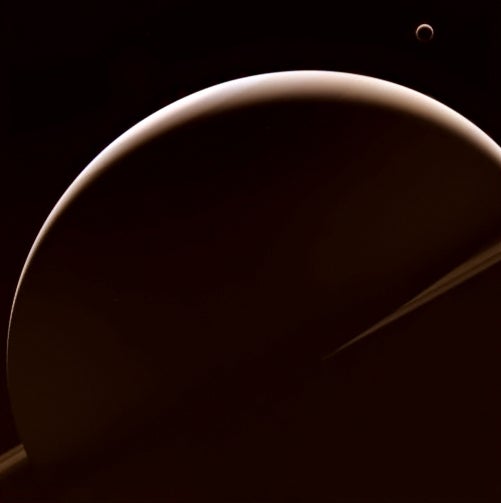
Friday, July 5
Earth’s orbit around the Sun is not perfectly circular, such that our planet sits marginally farther from the Sun in July and closer to it in January. Today, Earth reaches aphelion, that farthest point from the Sun, at 1 A.M. EDT. At that time, we are 94.5 million miles (151 million kilometers) from our star.
New Moon occurs this evening at 6:57 P.M. EDT, which is great news for those in the Northern Hemisphere hoping for a look at Comet 13P/Olbers, which is low but observable after sunset. An hour after sunset, the comet is 20° high in the northwest. It was recently recorded glowing at magnitude 6.7, great for larger binoculars or a small scope. For a signpost, you can use the magnitude 4 star 10 Ursae Majoris, which sits just less than 0.5° to the comet’s southwest.
Olbers is located in the constellation Lynx, just under the front feet of the Great Bear Ursa Major. As darkness falls, you’ll see the Big Dipper — standing on its bowl with the handle pointing straight up — appear higher in the northwest, well above the comet’s position. Much closer to the horizon and setting quickly is Cancer the Crab, carrying the famous open cluster M44. Swing your binoculars or scope down to see if you can catch the cluster in the 90 minutes or so after sunset, before it disappears below the horizon.
The dark, moonless skies will also allow observers to easily catch the dwarf planet 1 Ceres glowing at magnitude 7.3 as it reaches opposition in Sagittarius the Archer tonight at 8 P.M. EDT. Check out last Friday’s entry for more details on how to spot it, or tune in later this week, when we’ll stop back to take a look.
Sunrise: 5:38 A.M.
Sunset: 8:32 P.M.
Moonrise: 4:51 A.M.
Moonset: 8:56 P.M.
Moon Phase: New
*Times for sunrise, sunset, moonrise, and moonset are given in local time from 40° N 90° W. The Moon’s illumination is given at 12 P.M. local time from the same location.
Saturday, July 6
Early-morning observers can catch two of Jupiter’s moons crossing the giant planet with their shadows this morning, although what you’ll see depends on your location.
The gas giant rises in central Taurus around 3:15 A.M. local daylight time. Those on the East Coast and in the Midwest can catch the passage of Europa’s shadow across the disk, moving from east to west, visible as the planet is rising in these regions. Around 4:45 A.M. EDT, Europa itself moves onto the disk, again from the east moving west. Io (closer) and Callisto lie farther east, while Ganymede sits alone to the planet’s west.
Io’s shadow slips onto the disk around 5:15 A.M. CDT — after sunrise in the Eastern time zone and as twilight is brightening the sky in the Midwest. Europa’s shadow is now gone and Europa is approaching the western limb of the planet. Io follows its shadow just under an hour later, shortly after 5 A.M. MDT, and Europa slides off the disk just over 10 minutes later, at 5:12 A.M. MDT.
Sunrise: 5:38 A.M.
Sunset: 8:31 P.M.
Moonrise: 5:55 A.M.
Moonset: 9:39 P.M.
Moon Phase: Waxing crescent (1%)
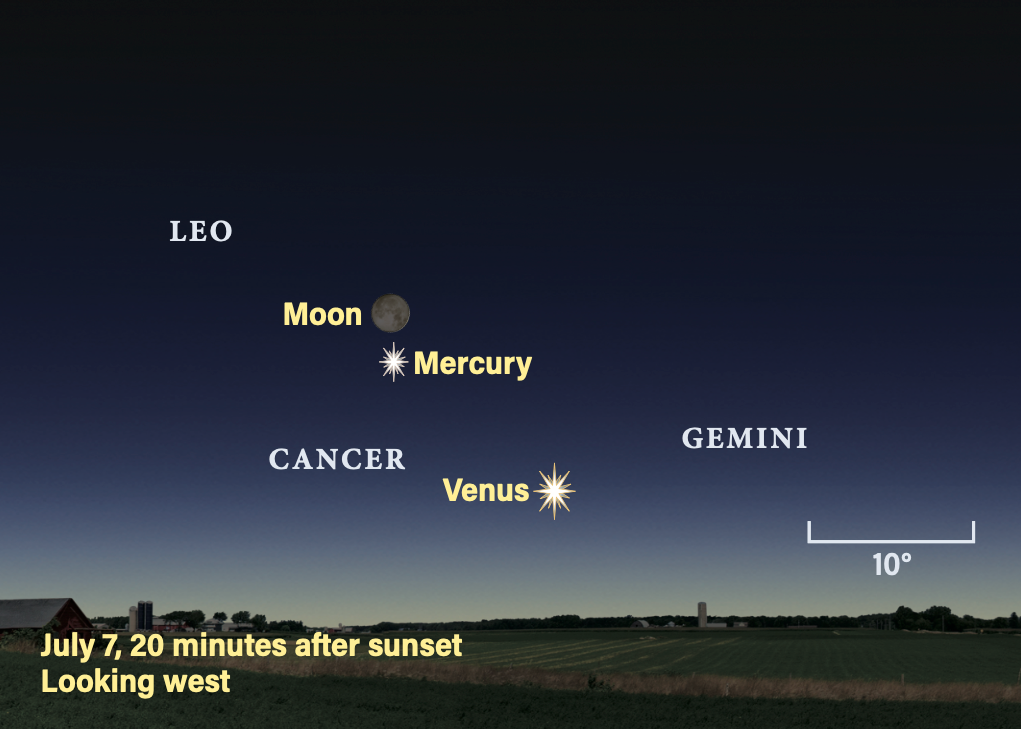
Sunday, July 7
The Moon passes 3° north of Mercury at 3 P.M. EDT. You can catch the pair, along with bright Venus, in the evening sky shortly after sunset — though you’ll need to be quick.
Some 20 minutes after sunset, Venus is just 2° high in the west. You’ll need a clear horizon to spot it; an observing location a bit higher than your surroundings will help as well. The planet glows a bright magnitude –3.9, which should help you spot it. Through a telescope, Venus appears fully lit (99 percent) and spans 10″.
To the upper left of Venus are Mercury and the Moon; our satellite is a delicate 5-percent-lit crescent hanging 3° above Mercury. The tiny planet glows at magnitude –0.2 and should pop out of the growing twilight. You’ll have longer to observe it, as it sits 10° high at this time. With the aid of a telescope, you’ll note that Mercury is only 67 percent lit and appears a little more than half the width of Venus, about 6″ on the sky.
Mercury is roughly 1.5° east of M44 — if you weren’t able to observe it on Friday, you might be able to catch the open cluster tonight, as it’s a bit higher above the horizon sooner after sunset — though the sky is also brighter. Binoculars or a telescope will certainly bring it out long before the sky is dark enough to see much with the naked eye.
Sunrise: 5:39 A.M.
Sunset: 8:31 P.M.
Moonrise: 7:02 A.M.
Moonset: 10:13 P.M.
Moon Phase: Waxing crescent (3%)
Monday, July 8
Saturn is rising around local midnight and presents a stunning sight with its rings nearly edge-on. The planet is currently tilted just 2° with respect to our line of sight; this tilt will increase over the next few months before decreasing again for 2025’s ring-plane crossing.
Located in Aquarius, Saturn glows at magnitude 0.9 and is easy to zero in on with a telescope. That’s exactly what you’ll want to do this morning to catch the planet’s largest moon, Titan, passing behind the disk and disappearing in an occultation. The event is visible in the eastern two-thirds of the U.S.; only those in the Pacific time zone won’t be able to watch it.
Titan is approaching the planet from the west as it rises; the large moon draws closer to the limb, finally disappearing around 2:40 A.M. EDT. At the same time, those with large scopes (10 inches) and video-capture systems may notice the smaller moon Mimas transiting the planet’s disk with its shadow. Mimas is moving from east to west, led by the shadow, passing in front of Saturn’s south polar region. Additional moons Enceladus and Tethys are hanging out just east of the eastern edge of the rings, while Dione and Rhea are to the west. These moons are all 10th magnitude or fainter, so may not be easily picked up in smaller scopes.
Sunrise: 5:40 A.M.
Sunset: 8:31 P.M.
Moonrise: 8:08 A.M.
Moonset: 10:40 P.M.
Moon Phase: Waxing crescent (8%)
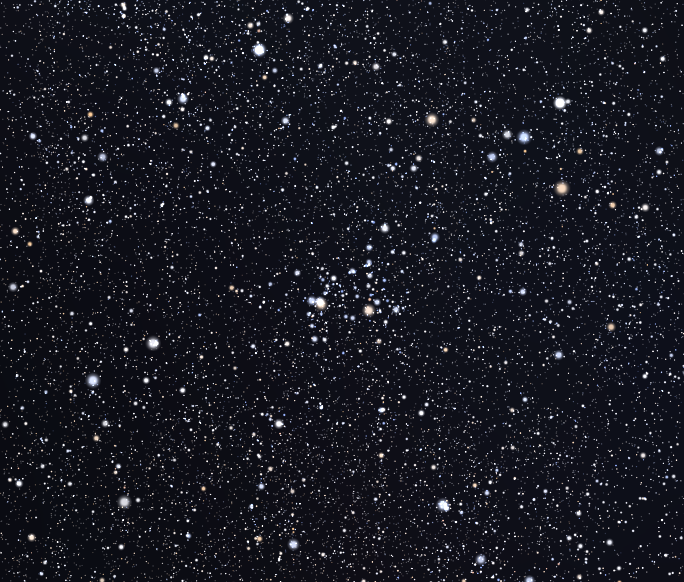
Tuesday, July 9
This evening, turn your eyes eastward as the constellation Aquila the Eagle climbs in the sky. The constellation is perhaps best known for its bright star Altair, which serves as one point in the famous Summer Triangle asterism. But Aquila is home to numerous deep-sky objects, including our target for tonight: NGC 6709, also known as the Flying Unicorn.
Located in the far western region of Aquila, near its border with Ophiuchus, this open cluster glows at magnitude 6.7 and spans about 15′ (or ¼°) on the sky. You can find it by skimming about 5° southwest of 3rd-magnitude Zeta (ζ) Aquilae.
NGC 6709 lies some 3,500 light-years away and contains a few hundred stars. Astronomers believe it is about 140 million years old. It is called the Flying Unicorn because some observers think its shape is akin to that of the mythological beast. What do you think? In the image above, the unicorn is facing to the right. Note that your telescope may flip or rotate the image you see compared to the one here.
Sunrise: 5:40 A.M.
Sunset: 8:30 P.M.
Moonrise: 9:13 A.M.
Moonset: 11:04 P.M.
Moon Phase: Waxing crescent (14%)
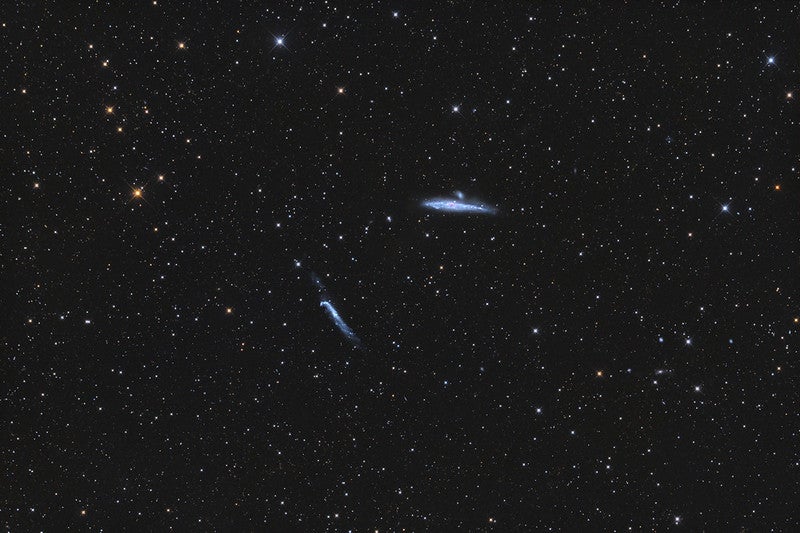
Wednesday, July 10
If you’ve got a larger scope (8 inches), tonight’s target should be on your list: the 9th-magnitude galaxy NGC 4631, also called the Whale Galaxy. You’ll find the constellation Canes Venatici beneath (to the left of) the Big Dipper’s handle in the north tonight before midnight. NGC 4631 is located about halfway on a line drawn between Cor Caroli (Canes Venatici’s alpha star) and Gamma (γ) Comae Berenices to its southwest. The galaxy itself is 6.5° southwest of Cor Caroli.
Measuring about 15′ along its longest side, the Whale Galaxy is an edge-on spiral with a bright center and mottled arms. Its shape has been distorted by a nearby satellite galaxy, NGC 4627, which itself has been heavily warped by the interaction. You may even be able to spot 12th-magnitude NGC 4627, some 2.5′ northwest of the larger galaxy.
The celestial cetacean also has another companion: 10th-magnitude NGC 4656, also called the Hockey Stick Galaxy. This sits just 0.5° east-southeast of the Whale Galaxy and short-focal-length telescopes will show both in the same field of view. Its heavily distorted shape also speaks to interactions with the Whale.
Sunrise: 5:41 A.M.
Sunset: 8:30 P.M.
Moonrise: 10:14 A.M.
Moonset: 11:25 P.M.
Moon Phase: Waxing crescent (21%)
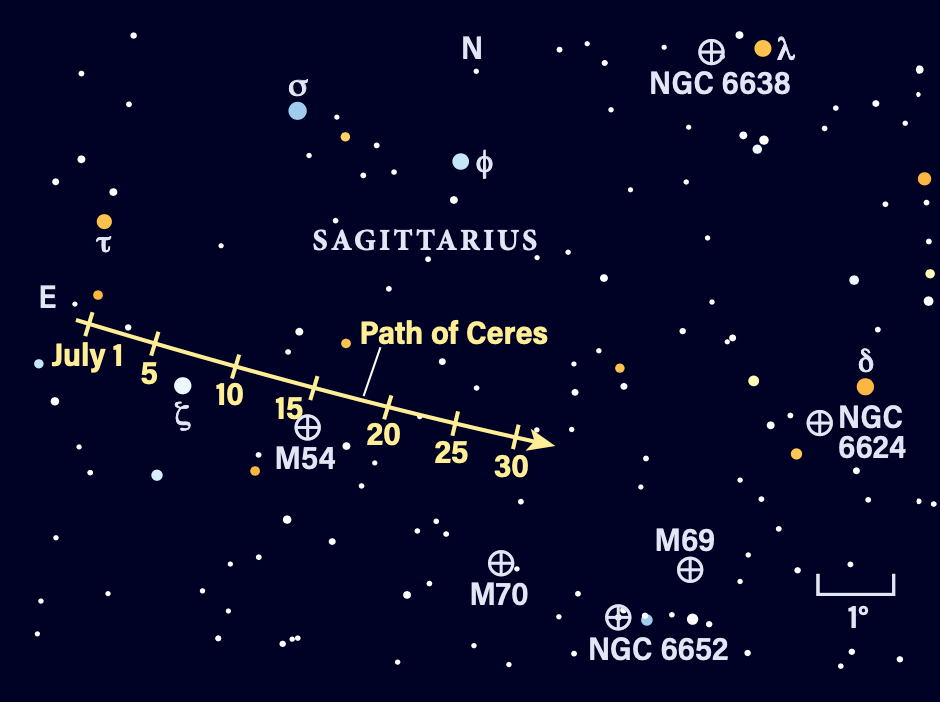
Thursday, July 11
Dwarf planet 1 Ceres is passing near the globular cluster M54 in Sagittarius the Archer. You can catch the pairing tonight in the south a few hours after sunset, as the Teapot asterism stands about 20° above the horizon (depending on your observing location, of course).
Ceres is near magnitude 2.6 Zeta Sagittarii, which links the base of the handle with the teapot’s body. With binoculars or a telescope, simply center on Zeta and then swing your view about 1° west of the star to spot the seventh-magnitude main-belt world.
M54 is just 1° southwest of Ceres, forming a triangle together with the dwarf planet and Zeta Sag. The globular cluster shines at magnitude 7.6 — roughly the same brightness as Ceres, though the compact ball of stars spans about 12′ in diameter. Located nearly 90,000 light-years away, M54 is likely not one of the Milky Way’s globulars at all, but instead belongs to the Sagittarius Dwarf Elliptical Galaxy, or SagDEG. This small satellite galaxy of the Milky Way was not discovered until 1994.
Ceres will swing closer to M54 over the next few days; it will stand due north of the cluster on the evening of the 15th.
Sunrise: 5:42 A.M.
Sunset: 8:29 P.M.
Moonrise: 11:14 A.M.
Moonset: 11:44 P.M.
Moon Phase: Waxing crescent (29%)
Friday, July 12
The Moon reaches apogee, the farthest point from Earth in its orbit, at 4:11 A.M. EDT, when it will sit 251,259 miles (404,362 km) away.
Mars and Uranus are drawing close together in the early-morning sky; they will pass within 0.6° of each other on the 15th. You can check their progress today in the two hours or so before sunrise, as the pair climbs in the eastern sky. Both are located in far western Taurus, to the right of the Pleiades star cluster. First-magnitude Mars is visible to the naked eye about 8° southwest of the cluster. The Red Planet’s disk spans some 6″ on the sky, currently the same apparent size as Mercury.
Once you’ve found Mars, you’ll need binoculars or a telescope to readily spot magnitude 5.8 Uranus. The distant ice giant sits just over 2° northeast of Mars and will appears as a “flat” gray star. Over the next few days, Uranus will appear to stay put as Mars draws closer, passing due south of the ice giant next week on Monday. We’ll certainly highlight the event, so check back for details then!
Sunrise: 5:42 A.M.
Sunset: 8:29 P.M.
Moonrise: 12:13 P.M.
Moonset: —
Moon Phase: Waxing crescent (38%)

Sky This Week is brought to you in part by Celestron.

